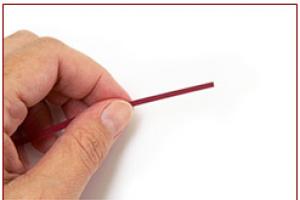A vice is one of the most important tools in any workshop. It allows you to expand the range of work and increase efficiency: thanks to them, the master’s hands are free, and the processing of parts is carried out on high level, and without outside help. Few people know that high-quality vices can be made with their own hands. You just need to show some ingenuity, skills and attentiveness. Next, about the intricacies of the process of creating a tool.
Vices are widely used in construction work as an element holding tool for various parts. The product in question is presented in the form of a base (body) with two clamping tubes, which allow you to firmly hold the part during milling, planing or drilling.
The vice is considered one of the main metalworking tools, because the quality of the parts will depend on the strength of fastening of the parts. final processing. In addition, such a product frees both hands, thus allowing you to carry out certain processes as accurately as possible.
Depending on the operational features, vices are divided into two categories: carpentry and metalworking. The latter, in turn, are divided into rotary and static. Static bench vices come in chair and parallel vices. The former do not have elements for permanent fastening and are easier to install/dismantle. The second ones differ more overall dimensions and are attached to work surface thoroughly.
Bench vices are designed primarily for working with fairly soft materials: plastic, wood, etc. They have high clamping jaws, which are either fixed statically or rotated on the base.
Machine tools are designed to work with hard materials, for example, metal. Their clamping jaws are less high for greater convenience and efficiency.
Making an instrument at home
To make a vice with your own hands, you need to prepare a certain set of materials and tools:
- Metal plates;
- Pins;
- Boards;
- Metal rod with a diameter of about 2 mm;
- Fasteners.
The minimum tools you will need are an electric drill, a sledgehammer, a file and a hacksaw. The easiest way to make a bench vise with your own hands is therefore presented below. step-by-step instruction to create just such a tool:

Advice. Vises made at home can be more effective and convenient due to the fact that it is quite possible to adapt them to carry out any specific operations.
If you plan to make a vice with your own hands, you should take into account some nuances that will determine the strength and service life of the tool:
- Material. Steel is most often used to create the product. It is advisable to choose a quality one, since the reliability and durability of the product, as well as its ability to firmly hold the part during processing, largely depend on this.
- Product size. If you plan to work primarily with small parts, it is better to give preference to a compact model: it will be more convenient and easier to work with.
- Thread pitch. Important point, which many often miss. The thread must be clear and small if spot work is planned.
- Sponges. It is important to pay attention to the size and shape of this element. The first indicator depends on the type of products that will be processed, the second - on the materials of the workpieces. If you plan to work only (mostly) with soft materials, it is better to make the jaws flat.
Advice. Since you're making your own vise, you can go beyond the standard model to make the best tool for your needs. Remember that with the help of an additional option you can make the vice more efficient in operation. For example, the presence of a rotating mechanism in the product will allow you to work with small parts.
That's all the subtleties that you should know about creating such a tool as a vice with your own hands. As you can see, this process is quite simple, and the result of the work will please even experienced craftsman. Good luck!
How to make a vice with your own hands: video
Bench vices are necessary equipment in the workshop of any man, without whom it is difficult to do in one form or another of work.
It is not at all necessary to place them in the garage; you can set up a corner for a vice at home, for example, using a table or an ordinary stool.

Why do you need a bench vise?
When processing or sharpening any part, it is necessary to fix it firmly and reliably, that is, to hold it in a certain position. The photo of the vice shows the operating principle of this equipment.
The parameters and dimensions of the vice are determined depending on what type of tool needs to be firmly held.

The design of a carpenter's vice includes:
- chassis screw;
- handle;
- movable and fixed sponge;
- base plate.

Main types of bench vices
Before making a vice with your own hands, you need to decide on the choice of work associated with it.

All types of vices are divided into two types:
- non-rotary have more simple design and they are easiest to make yourself. The part is fixed strictly in one position.
- Rotary vices are most often adapted for drilling on a machine. During operation, it is possible to rotate the workpiece without unclenching it.

The material of the vice body is most often made of durable cast iron. It is important to know that cast iron is not intended to be exposed to high temperatures, steel metal is suitable for these purposes.
If the work will be carried out with small-sized parts, you should not increase financial costs and make compact small vices.

A small vice with a ball joint base is useful on the farm for processing very small parts that can be secured individually. These are mini-vises with suction cups, mounted on a glass or well-polished surface. But they are suitable for rare non-serious work.

Please note that it is wise to install soft attachments on the fastening part for working with soft parts, so as not to cause damage to them. A vice with the least amount of play when the jaws are fully extended is the ideal option.

A vice without a rotating mechanism will save a lot of money, unless, of course, it is needed in the work.

Work on making a bench vice at home
Carpenter's vices, made independently at home, will save the family budget significantly more than their store-bought ready-made “brothers”. And a huge plus is that the product can be made according to personal preferences and for certain individual species works
It is absolutely easy to find material for the structure, it could be: a part technical pipe, used jack, old lathes, presses, etc.

And if you go to a metal collection point, there will undoubtedly be a suitable part for a vice that will cost you a penny.

Classic homemade vice
There are many types of vices, but the most popular and traditional is the type with steel material. Such a vice will be much more reliable than a factory-made one.

The structure consists of:
Note!

- a steel plate of at least 3 mm, but it can be much thicker;
- external and internal channel (120 and 100 mm);
- steel lugs;
- turning cutters 2 pieces;
- a small piece of reinforcement (rod for a gate);
- a nut (2 pieces), a pin or a screw of a certain diameter that corresponds to the rod;
- washer (2 pieces) of the same diameter with the lead screw;
- screw pair 335 mm;
- To secure the propeller chassis, a thick plate is needed.

It is necessary to separate the lead screw with washers on both sides of the plate. One of the two washers must be secured with a cotter pin or a locking ring, so that the part is completely removable; you must first weld the screw thread to it.

The handle should also be collapsible on one side, and reverse side It is worth welding it with a nut. It is necessary to weld a nut with a channel from the screws flush to the plate. To make the channel inside with the screw move easier while moving, it is recommended to lightly process it with a file.

Sponges are welded to the so-called ears, made from turning cutters. They are placed in the right place when the lead screw is screwed in, so the ears stand at the ideal distance from each other.

But you can also connect them with wire for greater convenience, so in the future it will be more convenient to fix uneven parts, the shape of which is expanded towards the bottom.

Such homemade vice Allows you to process larger parts.
Note!


To perform work in a home workshop, it is recommended to choose the simplest fixed vice for the machine.

It’s not at all difficult to make them yourself, you just have to watch the videos and recommendations, which can be found without much difficulty on the Internet and first draw up the drawings correctly.

DIY vise photo





Note!













If you have to change your workplace, you can equip each of them with a personal homemade, hand-made vice. Their design, like everything ingenious, lies on the surface and is simple but very effective, like much of what the famous one offers House master V. Legostaev.
Any self-respecting DIYer has a vice. However, a real full-fledged tool today is not only expensive, a good vice is also bulky and heavy. My workshop is actually the entire site: I have to work in different places, and a vice is needed very often. It turns out that you have to drag a heavy tool every time or run back and forth all the time to process parts.
Vise=Two pipes
It is known that gas and water pipes They are produced in such a way that any pipe must fit tightly inside a pipe of the next standard size. Taking this into account, I decided to take two pieces of pipe of two adjacent sizes. Inserted it into a large pipe and attached it to one of the ends using electric welding.
flange with nut large diameter- M16. On a smaller pipe, using the same electric welding, I installed a similar flange with a nut, but bigger size-M18. The M16 threaded rod in such a hole should rotate smoothly.
It was to this stud that I installed a nut at a short distance from the end, which was securely secured using electric welding. After that, I inserted a threaded rod into the cavity of the small pipe so that the fixed nut was inside the pipe and rested against the flange with a large hole. I screwed another nut onto the protruding end of the stud and also secured it by welding. Between the flange and the nuts, I pre-installed intermediate sliding washers. Now screw the end of the threaded rod that sticks out enough from the pipe into the nut big pipes. The result is the main working element of the vice. All that remained was to install the pressure plates (jaws) and support plates (paws) on the vice. I made the jaws from a square pipe, and the paws from a corner. And the vice is ready!
For ease of maintenance, I welded a nut to the protruding end of the threaded rod in such a way that, by inserting any rod into it, it was possible to easily rotate the axis and control the vice.
Homemade vices have disadvantages
When working on such a vise, the inner tube may rotate behind the pin, but this does not bother me at all. You just need to hold this pipe in the desired position when fixing it. And it’s not difficult to eliminate this drawback - just install the lock.
It’s even easier to make a vice from two scraps of square pipes that are similar in size. All technology remains the same.
DIY vice - photo
DIY vice: drawing
 1 PC. A3-A5 LED Luminous Drawing Graffiti Drawing Board...
1 PC. A3-A5 LED Luminous Drawing Graffiti Drawing Board...
202.24 rub.
Free shipping★★ ★★ ★★ ★★ ★★ (4.20) | Orders (114)
 A3 A4 A5 LED Luminous Drawing Graffiti Drawing Board...
A3 A4 A5 LED Luminous Drawing Graffiti Drawing Board...
Having made this vice for my carpentry workbench, you will be able to fasten wooden workpieces with a thickness of at least 150 mm. The simplicity of the design allows you to repeat the project yourself, with minimal welding and carpentry skills.
Appearance of a carpenter's vice without wooden jaws.
Tools and materials
To process steel elements of a carpentry vice you will need:
- Bulgarian.
- Brush attachment.
- Metal disc.
- Welding inverter.
- Electrodes.
- Drill and drill bits.
To make wooden parts you need a power saw, a plane and a sander.
Pick two steel pipes round or square cross-section so that one pipe fits tightly into the other. Use a threaded rod with a diameter of 12–18 mm as a lead screw. Prepare corners for the ties, the walls of which should be 2 times wider than the hole drilled for the screw.

Red dots mark lubrication points.
A table of significant details and dimensions of the metal part of the carpentry vice that explains the drawing.
|
Explanation |
||
|
fixed guide |
pipe 25x25x2 mm |
|
|
auxiliary hole |
||
|
screed support |
corner 24x24 mm |
|
|
lead screw nut |
||
|
mounting hole |
||
|
lead screw |
300 mm long |
|
|
movable guide |
pipe 20x20x2 mm |
|
|
thrust washer |
||
|
corner 24x24 mm |
||
|
corner 32x32 mm |
||
|
pipe or rod |
||
|
jaw mounting holes |
||
|
movable sleeve |
||
|
collar sleeve |
||
|
fixed bushing |
Making a carpenter's vice for a workbench with your own hands
Cut the parts with a grinder and make grooves at the ends of the corners to fit the square profile pipe. Select suitable washers and bushings for the clamping assembly, the inner diameter of which must match the caliber of the threaded rod.

Secure the ties with clamps and weld them to one profile pipe.

Install the second guide strictly parallel to the first and weld the parts.

Attention: even if you are not a professional welder, you will have to try and make welds that provide sufficient structural rigidity.
Sand the top surface with a sanding disc, removing any protrusions.

Insert the movable guides, align their ends and press the corner tie to them. Secure the parts by welding.

Install the vertical corners and weld them.

Drill holes for the screw in the middle of the corners. When marking their location, keep in mind that the rod must lie in the tie of the moving part so that the thrust washer can rotate.

Secure the running nut by welding. Assemble the clamping unit: first weld the collar to the bushing stud.

Now install the movable bushing and weld the thrust washer. To maintain the gap, insert a strip of thin tin under the corner.

Take care of the collar. If you use a half-inch pipe for it, then the nuts at the ends can be welded or secured to the threads and then cored.

Make mounting holes and clean the surfaces from scale and rust.

Coat the carpenter's vice with primer and paint.

Start making the wooden elements of a carpenter's vice.

Drawing of the wooden parts of a carpenter's vice: 1 – small fixed jaw; 2 – large movable sponge; 3 – support bar.
Prepare planed planks 22 mm thick from hard wood: make an allowance for the length of 15–20 mm, for the width of 3–4 mm, and for the movable jaw blanks, use 85 mm instead of 80 mm. Cut the support block straight to size from pine.

Glue two blanks.

After the glue has dried, cut the parts to a length of 320 mm.

Sharpen the stationary jaw to a fine finish and sand the front side. Secure wooden parts on the corners with screws through auxiliary holes.

Place the vise on the workbench, aligning the stationary jaw with the end of the tabletop. Secure with clamps and mark the drilling points.

After removing the fiberboard from the workbench cover, drill holes for the mounting bolts.

Make recesses in the tabletop for the hats with a feather drill.

Secure the vice with bolts with a diameter of at least 10 mm.

Sharpen the movable jaw to thickness and cut a groove for the weld.

Place the jaw in the vise and mark its exact height.

Remove excess wood with a plane and install the part in place.

Apply finishing compound to wooden elements, lubricate the rubbing parts of the clamping unit and the running nut.

The considered design of a carpenter's vice is both simple and reliable. Make this clamping device for your home workshop.
There is hardly a more necessary device in a home workshop than a bench vise. Even if you mostly work with wood, sometimes you won't be able to do without a vice. And if you don’t have a workshop, a garage or a corner in your apartment where you can repair simple household utensils, having a small benchtop bench vise can be a great help in many situations, turning kitchen table or even a stool for a mini-workshop.
First of all, about the purpose. The purpose of a vice is to securely fasten and hold a part or workpiece during processing. various instruments. Depending on what objects primarily need to be secured in a vice and what tools will be used to work with them, the design parameters of the vice vary. But the most universal and most common look like this:
The basis of any vice is a screw pair. In most cases, the screw is fixed in the movable part of the vice body, and the nut is fixed in the stationary part, which is either directly or through swivel mechanism attached to mechanic's workbench or a special stand that ensures the immobility of the vice during any operations with the part fixed in it.
Types of bench vices
In addition to reliable support, you must clearly understand what types of work you will be doing and relate the choice of bench vise to them. First of all, this concerns the material of the case. In the post-Soviet space, it is often cast iron.

This material is hard, wear-resistant, but quite fragile. Therefore, if you are not going to bend thick steel workpieces with a sledgehammer without seriously preheating them, then feel free to take such a vice, and if you do, then it’s better to look for a steel one.
If you need to regularly fasten workpieces in such a table vise cylindrical, then it is advisable to make an overlay for the sponge with a triangular cutout. And if such operations are quite frequent, then we advise you to consider options for the design of a bench vice that are somewhat different from the standard ones.

In general, if we talk about the functionality of a bench vice, then first of all you should think about the size. If you know for sure that you will not have to work with large parts, then do not pay for extra metal, and perhaps even consider a compact machine vice.

Or vice versa - it is possible to work with large-sized parts, but without much effort when processing them. Then you can consider the option of a vice with the ability to pre-expand the jaws without using a lead screw.

If you do not have a workbench, and also the list of works includes more operations that do not require the use of rough physical strength to the workpieces, then the option with a table vice, secured using various clamps, is yours.
True, the latter are mini-tise, it is better to have them on the farm as additional ones. Large details You can’t clamp it in them, and you can’t put any serious effort into the workpiece being processed - there’s not enough pressure on the clamp to hold the vices themselves, but making a key for a lock based on a sample is just the thing.
In addition, such vices are sometimes indispensable if you need to unscrew a stuck nut, when you can use them as hand tools. Despite their miniature size, their jaw pressure is very good.
It is also worth mentioning a small vice on a ball joint, which serves for the convenience of processing very small parts of complex configurations, allowing for processing various surfaces parts from one fastening.

It is clear that the clamping force of the ball joint is not enough for serious physical loads, so such a vice is suitable for quite specific types of work. The same, in our opinion not very serious, will be vices with fastening using a suction cup.

To secure them more or less securely, you need either a well-polished surface or glass. It is unlikely that they will be securely attached to other surfaces. And their functionality is also limited.
For all types of bench vices, you will obviously need additional pads to secure parts made from soft materials.
Some bench vise They have a pneumatic drive, which greatly facilitates the process of securing the workpiece.

But if you don’t have a mini plumbing workshop at home, then you are unlikely to need such a vice.

What else is important to know when choosing a bench vise? There are quite a lot of complaints from users about Chinese vices with cast iron bodies, equipped with clamps for fastening - they often break off, so if you want a cheap vice from the Middle Kingdom, it is better to choose one made of steel.
Choose a vice that has the least amount of play between the body parts when the jaws are set as far apart as possible. Also, if you do not need a rotating mechanism at the base of the vice for work, choose a model without it: you will save money and the structure is more rigid.
How to make a bench vise with your own hands
The question arises: why, with such an abundance of sizes, shapes and configurations of bench vices offered by the retail chain, bother with them? independent execution. When making a bench vice with your own hands, you can save up to 10 times in cost, and also make a device with the specified parameters.

And this is absolutely real, because almost everything that can be useful for making a table vice can be found at scrap metal collection points for mere pennies.

This is especially noticeable in the photograph, in which parts of a plumbing pipe valve with a flywheel are used as a screw pair.

You can also take a screw pair from an old vertical jack. Even if part of the thread has already worn slightly, then, as a rule, this is a small area from the edge of the screw, which will still need to be trimmed to shorten it. The lead screws of old lathes, screw presses, etc. are also very durable.
At worst, for very little money you can order a turner at the nearest vocational school such a pair with a wide nut, with a regular metric thread. Just make the diameter larger and the nut wider. In this case, the clamping force will be redistributed over a sufficiently large area due to the diameter of the screw and the number of turns.
IN as a last resort, just buy a stud with a larger diameter in a store that sells hardware, and a tall nut for it, or 3 regular pieces, which you then weld in series, screwed onto the stud.
The classic version of a homemade bench vise

The photograph clearly shows the steel parts, which can almost always be picked up without much difficulty at the nearest metal shop:
- steel plate 200 x 200, thickness 3 – 6 mm (thicker is possible);
- 2 channels (120 mm - external, 100 mm - internal) with a length of 160 mm and 300 mm, respectively; in your case, the dimensions may be different depending on the length of the lead screw;
- steel ears from some large container;
- 2 worn turning tools;
- rod for the wrench, in this case a piece of reinforcement;
- a screw or pin corresponding to the diameter of the rod, and 2 nuts;
- 2 washers, with a diameter corresponding to the diameter of the lead screw;
- screw pair - any of those described (in this case - ordered by a turner), 335 mm long;
- powerful plate for fastening the lead screw.
The lead screw on both sides of the plate is separated by washers, one of which, on the side of the threaded part, is welded to it, although with this diameter it can be secured with a cotter pin or retaining ring. Then this unit will be completely dismountable, which is clearly better for reasons of maintainability.
The handle on one side is sealed with a welded nut, and on the other side it is made collapsible after welding the thread from a screw of the appropriate diameter to it.
The nut from the screw pair is welded to the base plate flush with the 120 channel.

For normal fit of the inner channel with the lead screw attached to it, its ribs need to be lightly processed with a file.

Ears with jaws welded to them, made from trimmed turning tools, must be positioned when screwed in lead screw. This way they will take the exact place. You can even twist the jaws together with soft wire, ensuring their ideal position.
You can also first apply a notch to them using an angle grinder with a metal cutting disc.
Due to this type of fastening of the jaws, namely the shape of the hooks and the distance between them, non-standard parts that are widened towards the bottom can be fastened in such a vice.

And the maximum thickness of workpieces processed in these vices is quite impressive. And there is no need to talk about the maintainability of such equipment - you can see for yourself.
Dear readers, if you have any questions, please ask them using the form below. We will be glad to communicate with you;)








